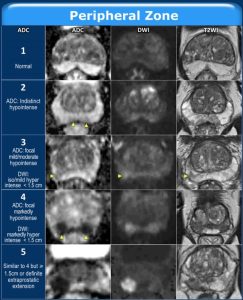 PI-RADS (Prostate imaging Reporting and Data System) is a rating scale for the likelihood that clinically significant prostate cancer (PCa) is present.
PI-RADS (Prostate imaging Reporting and Data System) is a rating scale for the likelihood that clinically significant prostate cancer (PCa) is present.
It is a 5-number system, from least likely to most likely:
PI-RADS 1
Very low risk.
Clinically significant cancer is highly unlikely to be present.
PI-RADS 2
Low risk.
Clinically significant cancer is unlikely to be present.
PI-RADS 3
Intermediate risk. Clinically significant cancer may or may not be present.
PI-RADS 4
High risk. Clinically significant cancer is likely to be present.
PI-RADS 5
Very high risk.
Clinically significant cancer is highly likely to be present.
The PI-RADS system improves agreement among radiologists who interpret prostate MRI scans by providing detailed, standardized descriptions of what imaging sequences to use, and how PCa shows up in each sequence.
Gleason grade/score
Grade Group (GG):
Recognizes 5 different patterns (grades) of PCa cells as seen under a microscope.
Gleason score is always shown as the sum of 2 numbers (e.g., 3+4=7) based on the 2 highest proportions of the most aggressive pattern in each biopsy needle sample.
GG1 – low risk (Gleason score 3+3=6)
GG2-favorable intermediate risk (Gleason score 3+4=7)
GG3- unfavorable intermediate risk (Gleason score 4+3=7)
GG4 – high risk (Gleason score 4+4=8)
GG5 – high risk (Gleason score 9 or 10)
Before mpMRI, the only pathway to diagnose PCa was invasive from a suspicious PSA blood test result to a 12+ needle biopsy guided by transrectal ultrasound (TRUS).
TRUS biopsy have risks: infection, bleeding, pain.
TRUS biopsy it has at least a 30% error margin.
It over-detects insignificant cancer, and often misses significant cancer, leading to treatment mismatch, side effects and poor outcomes.
Men with suspicious PSA results can take advantage of an intermediate step before biopsy: mpMRI.
When performed by an expert on a powerful magnet, the PI-RADS score can make the difference between biopsy not needed (PI-RADS 1 or 2) or biopsy needed (PI-RADS 3, 4 or 5).
Studies show that, with mpMRI and PI-RADS, up to 50% of patients will not need a biopsy at the time of the scan.
If PI-RADS shows likelihood of clinically significant cancer, a needle biopsy is the only responsible way to make a diagnosis because it’s based on actual tissue examined under a microscope.
Such a biopsy can identify if cancer is present and demonstrates its location, shape, size and aggression
MRI guidance allows precise targeting.
Real time MRI is more accurate than fusion-guided biopsies because it’s done in real time while the patient lies in the opening of the magnet.
Fusion biopsy is most often accompanied by additional systematic needle sampling, because of being less accurate.
